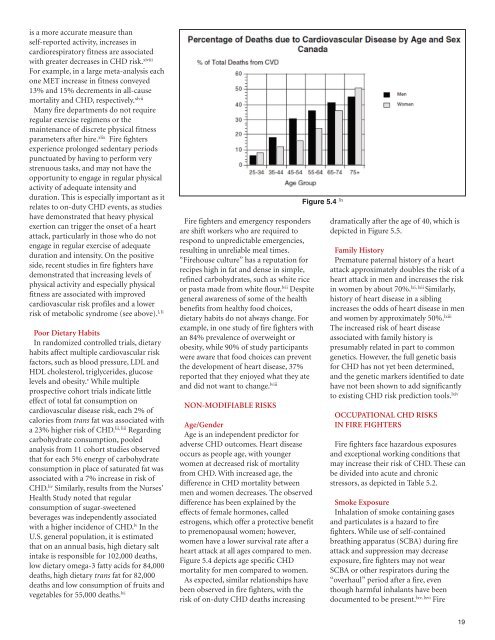Heart disease in tHe fire service - West Valley City Firefighters, IAFF ...
Heart disease in tHe fire service - West Valley City Firefighters, IAFF ...
Heart disease in tHe fire service - West Valley City Firefighters, IAFF ...
Create successful ePaper yourself
Turn your PDF publications into a flip-book with our unique Google optimized e-Paper software.
is a more accurate measure than<br />
self-reported activity, <strong>in</strong>creases <strong>in</strong><br />
cardiorespiratory fitness are associated<br />
with greater decreases <strong>in</strong> CHD risk. xlviii<br />
For example, <strong>in</strong> a large meta-analysis each<br />
one MET <strong>in</strong>crease <strong>in</strong> fitness conveyed<br />
13% and 15% decrements <strong>in</strong> all-cause<br />
mortality and CHD, respectively. xlvii<br />
Many <strong>fire</strong> departments do not require<br />
regular exercise regimens or the<br />
ma<strong>in</strong>tenance of discrete physical fitness<br />
parameters after hire. xlix Fire fighters<br />
experience prolonged sedentary periods<br />
punctuated by hav<strong>in</strong>g to perform very<br />
strenuous tasks, and may not have the<br />
opportunity to engage <strong>in</strong> regular physical<br />
activity of adequate <strong>in</strong>tensity and<br />
duration. This is especially important as it<br />
relates to on-duty CHD events, as studies<br />
have demonstrated that heavy physical<br />
exertion can trigger the onset of a heart<br />
attack, particularly <strong>in</strong> those who do not<br />
engage <strong>in</strong> regular exercise of adequate<br />
duration and <strong>in</strong>tensity. On the positive<br />
side, recent studies <strong>in</strong> <strong>fire</strong> fighters have<br />
demonstrated that <strong>in</strong>creas<strong>in</strong>g levels of<br />
physical activity and especially physical<br />
fitness are associated with improved<br />
cardiovascular risk profiles and a lower<br />
l, li<br />
risk of metabolic syndrome (see above).<br />
Poor Dietary Habits<br />
In randomized controlled trials, dietary<br />
habits affect multiple cardiovascular risk<br />
factors, such as blood pressure, LDL and<br />
HDL cholesterol, triglycerides, glucose<br />
levels and obesity. v While multiple<br />
prospective cohort trials <strong>in</strong>dicate little<br />
effect of total fat consumption on<br />
cardiovascular <strong>disease</strong> risk, each 2% of<br />
calories from trans fat was associated with<br />
a 23% higher risk of CHD. lii, liii Regard<strong>in</strong>g<br />
carbohydrate consumption, pooled<br />
analysis from 11 cohort studies observed<br />
that for each 5% energy of carbohydrate<br />
consumption <strong>in</strong> place of saturated fat was<br />
associated with a 7% <strong>in</strong>crease <strong>in</strong> risk of<br />
CHD. liv Similarly, results from the Nurses’<br />
Health Study noted that regular<br />
consumption of sugar-sweetened<br />
beverages was <strong>in</strong>dependently associated<br />
with a higher <strong>in</strong>cidence of CHD. lv In the<br />
U.S. general population, it is estimated<br />
that on an annual basis, high dietary salt<br />
<strong>in</strong>take is responsible for 102,000 deaths,<br />
low dietary omega-3 fatty acids for 84,000<br />
deaths, high dietary trans fat for 82,000<br />
deaths and low consumption of fruits and<br />
vegetables for 55,000 deaths. lvi<br />
Fire fighters and emergency responders<br />
are shift workers who are required to<br />
respond to unpredictable emergencies,<br />
result<strong>in</strong>g <strong>in</strong> unreliable meal times.<br />
“Firehouse culture” has a reputation for<br />
recipes high <strong>in</strong> fat and dense <strong>in</strong> simple,<br />
ref<strong>in</strong>ed carbohydrates, such as white rice<br />
or pasta made from white flour. lvii Despite<br />
general awareness of some of the health<br />
benefits from healthy food choices,<br />
dietary habits do not always change. For<br />
example, <strong>in</strong> one study of <strong>fire</strong> fighters with<br />
an 84% prevalence of overweight or<br />
obesity, while 90% of study participants<br />
were aware that food choices can prevent<br />
the development of heart <strong>disease</strong>, 37%<br />
reported that they enjoyed what they ate<br />
and did not want to change. lviii<br />
NON-MODIFIABLE RISKS<br />
Age/Gender<br />
Age is an <strong>in</strong>dependent predictor for<br />
adverse CHD outcomes. <strong>Heart</strong> <strong>disease</strong><br />
occurs as people age, with younger<br />
women at decreased risk of mortality<br />
from CHD. With <strong>in</strong>creased age, the<br />
difference <strong>in</strong> CHD mortality between<br />
men and women decreases. The observed<br />
difference has been expla<strong>in</strong>ed by the<br />
effects of female hormones, called<br />
estrogens, which offer a protective benefit<br />
to premenopausal women; however,<br />
women have a lower survival rate after a<br />
heart attack at all ages compared to men.<br />
Figure 5.4 depicts age specific CHD<br />
mortality for men compared to women.<br />
As expected, similar relationships have<br />
been observed <strong>in</strong> <strong>fire</strong> fighters, with the<br />
risk of on-duty CHD deaths <strong>in</strong>creas<strong>in</strong>g<br />
Figure 5.4 lix<br />
dramatically after the age of 40, which is<br />
depicted <strong>in</strong> Figure 5.5.<br />
Family History<br />
Premature paternal history of a heart<br />
attack approximately doubles the risk of a<br />
heart attack <strong>in</strong> men and <strong>in</strong>creases the risk<br />
<strong>in</strong> women by about 70%. lxi, lxii Similarly,<br />
history of heart <strong>disease</strong> <strong>in</strong> a sibl<strong>in</strong>g<br />
<strong>in</strong>creases the odds of heart <strong>disease</strong> <strong>in</strong> men<br />
and women by approximately 50%. lxiii<br />
The <strong>in</strong>creased risk of heart <strong>disease</strong><br />
associated with family history is<br />
presumably related <strong>in</strong> part to common<br />
genetics. However, the full genetic basis<br />
for CHD has not yet been determ<strong>in</strong>ed,<br />
and the genetic markers identified to date<br />
have not been shown to add significantly<br />
to exist<strong>in</strong>g CHD risk prediction tools. lxiv<br />
OCCUPATIONAL CHD RISKS<br />
IN FIRE FIGHTERS<br />
Fire fighters face hazardous exposures<br />
and exceptional work<strong>in</strong>g conditions that<br />
may <strong>in</strong>crease their risk of CHD. These can<br />
be divided <strong>in</strong>to acute and chronic<br />
stressors, as depicted <strong>in</strong> Table 5.2.<br />
Smoke Exposure<br />
Inhalation of smoke conta<strong>in</strong><strong>in</strong>g gases<br />
and particulates is a hazard to <strong>fire</strong><br />
fighters. While use of self-conta<strong>in</strong>ed<br />
breath<strong>in</strong>g apparatus (SCBA) dur<strong>in</strong>g <strong>fire</strong><br />
attack and suppression may decrease<br />
exposure, <strong>fire</strong> fighters may not wear<br />
SCBA or other respirators dur<strong>in</strong>g the<br />
“overhaul” period after a <strong>fire</strong>, even<br />
though harmful <strong>in</strong>halants have been<br />
documented to be present. lxv, lxvi Fire<br />
19

















